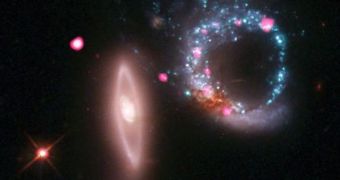Observations conducted with two NASA telescopes reveal the intricacies of the Arp 147 galactic system, a group of two interacting galaxies that produce some interesting effects in their surroundings.
At one time, the galaxies making up this system were separate and distant. The one on the right side of this image was a fully-fledged spiral galaxies. Now, it's only a shadow of its former self, after having interacted constantly and for a long time with its elliptical companion.
Due to the interplay of tidal and gravitational forces, the former spiral galaxy has now been converted into an expanding arc that features massive areas of stellar formation within. Numerous new, blue stars are born within, as evidenced by the hues visible in this photo.
The massive stars that are born in this region reach the end of their burning cycle in just a few million years, and they blow up in powerful supernova explosions. As this happens, their cores implode, and form black holes or neutron stars.
Astronomers say that the galaxy on the right is now filled with such cosmic objects, which interact in very peculiar manner with the remnants of its elliptical companion.
The system was recently observed by astronomers using the NASA Spitzer Space Telescope, which images the sky in infrared wavelengths. These observations were augmented by ultraviolet studies conducted with the NASA Galaxy Evolution Explorer (GALEX) satellite.
The combined view reveals several powerful X-ray sources (violet), which dot the spiral galaxies. These sources are special types of black holes, which emit so much radiation because they have companion stars, from which they accrete material.
Such events produce complex interactions, that lead to the formation of massive amount of radiation. A similar source – most likely a supermassive black hole as well – can be seen in the elliptical galaxy on the left portion of the view.
Data derived from telescope observations reveal that the most intense period for stellar formation ended some 15 million years ago. As such, we could expect to see many supernova explosions coming from the Arp 147 system in the near astronomical future.
Hundreds of millions of years from now, all massive stars will have died out, and the galactic system will have found its peace. Most likely, the two galaxies will unite to form a single structure. This event may also trigger the formation of new stars yet again, Daily Galaxy reports.

 14 DAY TRIAL //
14 DAY TRIAL //